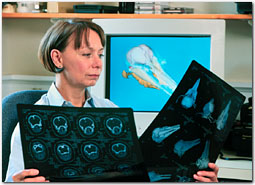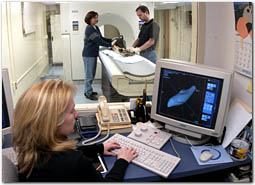
|
 |
Science Highlights > Learning What Whales Hear
Learning What Whales Hear
 |

Click to enlarge
|
|
Darlene Ketten with images of a beaked whale skull. (Photo by Tom Kleindinst) |
They come in all shapes, sizes, and species-from seals and whales to squirrels and hippos, the Marine Sensory Systems Laboratory (MSSL) in the Biology Department scans them all. As the only US oceanographic research institution with a computerized tomographic (CT) 2-D/3-D scanner, WHOI is bringing advanced technology to bear on many fundamental questions in the marine environment.
The lab, headed by Senior Scientist Darlene Ketten, compares hearing and other sensory systems in terrestrial and aquatic animals, undertakes forensics studies for the National Marine Fisheries Service to try to determine why marine mammals strand, and conducts basic research in a variety of disciplines.
For Ketten and colleagues, 2002 had many highlights. Not only was she awarded tenure and promoted to Senior Scientist, but the lab installed a new water-cooled CT scanner, similar to those used at Massachusetts General Hospital, to perform studies in 20 minutes that previously took four hours. Specimens arriving at the lab from around the world often undergo both digital and physical dissection, complementary approaches that allow Ketten to first examine hearing-related structures and other organs and then to study them on a microscopic level.

Click to enlarge
|
 |
|
CT Technologist Julie Arruda, front, works with Postdoctoral Investigator Soraya Moein Bartol and Research Assistant Scott Cramer imaging a white sided-dolphin that was stranded. 3D reconstructions of the dolphin are visible on the two workstations. (Photo by Tom Kleindinst)
|
This combination of techniques has been critical to wide-ranging studies of hearing in beaked whales, a major focus of lab activity in 2002. Little is known about this species, but early MSSL studies indicate that the shape and composition of fatty deposits in the beaked whale’s jaw may be critical to what this species can hear. The scanner has also been used to better understand the physical shape and function of skulls and other body parts such as the olfactory system in sea otters and the overall shape of porpoises, the latter as part of collaborative studies with Frank Fish at West Chester University to determine how they “fly” underwater. Applying the principles of “biomimetics,” engineers can map the 3-D geometry of the dolphin to help develop more efficient autonomous underwater vehicles.
Funding for MSSL in 2002 was provided by ONR, NOAA, and the Northeast Consortium.
|
|
